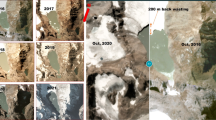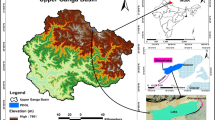Abstract
In recent years, climate change and retreating glaciers constitute a major hazard in the Himalaya of South Asia. Glacial lakes are rapidly developing or increasing due to climate change. The rapid development of the lake may cause outburst of the lake. The outburst discharge from the glacial lake can cause catastrophic flooding and disaster in downstream area. Therefore, it is necessary to investigate the impact of climate change on glacial lakes and to understand the characteristics of the glacial lake outburst. In this study, the field assessment of Tsho Rolpa Glacial Lake in the Himalaya of Nepal has been presented and the impact of climate change on this glacial lake has been discussed. The Tsho Rolpa Glacial Lake is the largest and most potentially dangerous glacial lake in Nepal. In addition, a numerical model has been also developed for computing the characteristics of glacial lake outburst due to moraine dam failure by seepage and water overtopping. The numerical model is tested for the flume experimental cases. The simulated results of the outburst discharge, the dam surface erosion, and the temporal variation of the moisture movement in the dam are compared with those obtained from the hydraulic model experiments. The moisture profile calculated by numerical model was agreeable with the experimental moisture profile. The simulated failure surface of the dam due to seepage by considering the suction in slope stability analysis gave more agreeable results than the Janbu's simplified method. The results of the outburst discharge and dam surface erosion also agreed with the experimental results.





















Similar content being viewed by others
References
Bajracharya OR (2008) Himalayan glacier and glacier lake outburst flood (GLOF). SAARC Workshop on Climate Change and Disaster: Emerging Trends and Future Strategies, Kathmandu, Nepal
Bajracharya SR (2010) Glacial lake outburst flood disaster risk reduction activities in Nepal. International Journal of Erosion Control Engineering 3(1):92–101
Bajracharya SR, Mool PK, Shrestha BR (2006) The impact of global warming on the glaciers of the Himalaya. International Symposium on Geo-disasters, Infrastructure Management and Protection of World Heritage Sites, Nepal Engineering College, Ehime University and National Society for Earthquake Technology, Nepal, pp.231–242
Bajracharya SR, Mool PK, Shrestha BR (2007a) Impact of climate change on Himalayan glaciers and glacial lakes, case studies on GLOF and associated hazards in Nepal and Bhutan. International Centre for Integrated Mountain Development (ICIMOD) and United Nations Environment Programme (UNEP), pp.1–119
Bajracharya B, Shrestha AB, Rajbhandari L (2007b) Glacial lake outburst floods in the Sagarmatha region. Mt Res Dev 27(4):336–344
Cenderelli AD, Wohl EE (2001) Peak discharge estimates of glacial-lake outburst floods and “normal” climatic floods in the Mount Everest region, Nepal. Geomorphology 40:57–90
Clague JJ, Evans SG (2000) A review of catastrophic drainage of moraine-dammed lakes in British Columbia. Quat Sci Rev 19:1763–1783
Costa JE, Schuster RL (1988) The formation and failure of natural dams. Geol Soc Am Bull 100:1054–1068
Evans SG (1986) The maximum discharge of outburst floods caused by the breaching of man-made and natural dams. Can Geotech J 23:385–387
Fread DL (1988) DAMBRK: the NWS DAMBRK model: Theoretical background/user documentation. Hydrologic Research Laboratory, Office of Hydrology, NWS, NOAA
Fread DL (1991) BREACH: an erosion model for earthen dam failures. U.S. National Weather Service, Office of Hydrology, Silver Spring, Maryland
Freeze RA (1978) Mathematical models of hillslope hydrology. In: Kirkby MJ (ed) hillslope hydrology. Wiley, New York, pp 177–225
Fujita K, Kadota T, Rana B, Kayastha RB, Ageta Y (2001) Shrinkage of Glacier AX010 in Shorong region, Nepal Himalayas in the 1990s. Bull Glaciol Res 18:51–54
Horstmann B (2004) Glacial lake outburst floods in Nepal and Switzerland–new threats due to climate change. Germanwatch, pp.1–11. http://www.germanwatch.org/download/klak/fb-gl-e.pdf. Accessed 26 April 2010
Huggel C, Haeberli W, Kääb A, Bieri D, Richardson S (2004) An assessment procedure for glacial hazards in the Swiss Alps. Can Geotech J 41:1068–1083
Matambo ST, Shrestha AB (2011) Nepal: Responding Proactively to Glacial Hazards, World Resources Report, Washington DC, pp.1–18. http://www.worldresourcesreport.org. Accessed 15 May 2011
Mool PK (2010) Glacial lakes and glacial lake outburst floods in the Himalayas. International Centre for Integrated Mountain Development (ICIMOD). http://geoportal.icimod.org/symposium2010/PPT/Theme-I/PK%20Mool.pdf. Accessed 25 April 2011
Mool PK, Bajracharya SR, Joshi SP (2001) Risk assessment of Tsho Rolpa Glacial Lake along the Rolwaling and Tama Koshi valleys, Dolakha District, Nepal. United Nations Environment Programme—Asia and the Pacific (UNEP-AP) and International Centre for Integrated Mountain Development (ICIMOD)
Nakagawa H (1989) Study on risk evaluation of flood and sediment inundation disaster, Doctoral Thesis, Kyoto University (in Japanese)
Nakagawa H, Utsumi T, Kawaike K, Baba Y, Zhang H (2011) Erosion of unsaturated river embankment due to overtopping water. Annual Journal of Hydraulic Engineering, JSCE, Keynote Lecture, 55:K-1–K-4
Osti R, Egashira S (2009) Hydrodynamic characteristics of the Tam Pokhari glacial lake outburst flood in the Mt. Everest region, Nepal. Hydrol Process 23:2943–2955
Reynolds JM (1999) Glacial hazard assessment at Tsho Rolpa, Rolwaling, Central Nepal. Quarterly Journal of Engineering Geology, the Geological Society of London 32:209–214
Richardson SD, Reynolds JM (2000a) An overview of glacial hazards in the Himalayas. Quat Int 65(66):31–47
Richardson SD, Reynolds JM (2000b) Degradation of ice-cored moraine dams: implications for hazard development. In: Nakawo M, Raymond CF, Fountain A (eds) Debris-covered Glaciers, IAHS Red Book series, 264:187–198
Shrestha AB, Eriksson M, Mool P, Ghimire P, Mishra B, Khanal NR (2010) Glacial lake outburst flood risk assessment of Sun Koshi basin, Nepal. Geomatics, Natural Hazards and Risk 1(2):157–169
Takahashi T (1991) Debris flow. IAHR Monograph Series. Balkema, Rotterdam
Takahashi T, Nakagawa H, Harada T, Yamashiki Y (1992) Routing debris flows with particle segregation. J Hydraul Eng 118(11):1490–1507
Takahashi T, Nakagawa H, Satofuka Y (2001) Prediction of reservoir sedimentation and development of reduction system for the sedimentation. Annuals of Disaster Prevention Research Institute, Kyoto University, Japan, 44(B-2):193–206 (in Japanese with English abstract)
U.S. Corps of Engineers (2002) HEC-RAS river analysis system hydraulic reference manual. Hydraulic Engineering Center Report, CPD-69. US Corps of Engineers, Davis
van Genuchten MT (1980) A closed-form equation for predicting the hydraulic conductivity of unsaturated soils. Soil Sci Soc Am J 44:892–898
Vanapalli SK, Fredlund DG, Pufahl DE, Clifton AW (1996) Model for the prediction of shear strength with respect to soil suction. Can Geotech J 33:379–392
Wang X, Lui S, Guo W, Xu J (2008) Assessment and simulation of glacier lake outburst floods for Longbasaba and Pida lakes, China. Mt Res Dev 28(3/4):310–317
WECS (Water and Energy Commission Secretariat) (1993) Interim report on the field investigation on the Tsho Rolpa Glacier Lake, Rolwaling valley. WECS, Nepal Government
Yamada T (1998) Glacier lake and its outburst flood in the Nepal Himalaya. Data Center for Glacier Research. Japanese Society of Snow and Ice, Monograph 1:1–96
Acknowledgments
The authors are grateful to the GCOE program ‘Sustainability/Survivability Science for a Resilient Society Adaptable to Extreme Weather Conditions’ of Disaster Prevention Research Institute, Kyoto University for providing financial support for this research work.
Author information
Authors and Affiliations
Corresponding author
Rights and permissions
About this article
Cite this article
Shrestha, B.B., Nakagawa, H., Kawaike, K. et al. Glacial hazards in the Rolwaling valley of Nepal and numerical approach to predict potential outburst flood from glacial lake. Landslides 10, 299–313 (2013). https://doi.org/10.1007/s10346-012-0327-7
Received:
Accepted:
Published:
Issue Date:
DOI: https://doi.org/10.1007/s10346-012-0327-7




